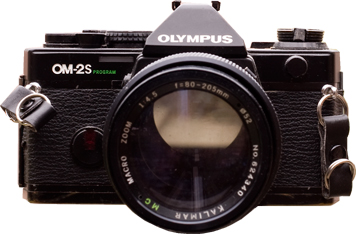
Approx. dates of manufacture: 1984-1988
Lens Mount: Olympus OM
Battery: two 1.5v LR44 (357)
Approx. original price: $279.95
Approx. street value: moderate
Acquired in a box of parts cameras, along with a couple more dead Olympus OM bodies, half a Yashica something, a black Mamiya 1000 DTL, and a couple more skeletons that are unidentifiable.
For years I thought this was a wreck. It wasn't until I was poking through the parts box again that I realized it was complete, except for a lens and the screw-cover for the motor-drive linkage. I'd subsequently acquired an Olympus-mount lens, so I dropped in the necessary batteries and was shocked to find that it fired consistantly, and everything appears to work. (Even though it also looks complete, my plain OM-2 is still dead.)
Olympus is an interesting company. They always lagged behind the big guys (Canon, Minolta and Nikon) for the mass market, so they tended to cut their own niche. In the 1960s, they led the half-frame 35mm (see my Canon Demi) with their Pen series. In the 1970s, they felt confident enough to introduce their own full-frame SLR, which they called the OM-1. But rather than just make a "me too" camera, they engineered the hell out of it and made it smaller and lighter than the competition, but made sure that the quality was there.
The OM-1 was a middle-teir camera; they followed up with the professional level OM-2, and again, Olympus made sure they had a compelling reason for people to buy it. The best of the new features was the off-the-film (OTF) plane metering, which many people felt was far superior to the in-camera metering that measured the light off the ground glass in the pentaprism.
The problem was that they didn't have another hole card to play after this; they upgraded the OM-1 as the OM-3, and the OM-2 as the OM-4. The went down-market a bit with the OM-10, and released a slew of rangefinders to compete against Canon's Sure Shot series. But the fireworks were over; the subsequent OM bodies were evolutionary, not revolutionary. Then they lost ground rapidly in the 80s as Minolta smoked everyone with the autofocus Maxxum; Canon and Nikon made the hard choices and eventually caught up but Olympus struggled. They were, however, early into digital and made a lot of nice consumer level cameras, but never figured out how to steal a march on Canon and Nikon and offer something everyone wanted and nobody else had.
One of Modern Photography magazine's Top Cameras
Camera manual: Orphan Cameras.com


